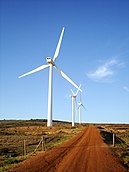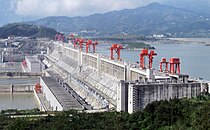| Part of a series on |
| Sustainable energy |
|---|
 |
Renewable energy (or green energy) is energy from renewable natural resources that are replenished on a human timescale. The most widely used renewable energy types are solar energy, wind power, and hydropower. Bioenergy and geothermal power are also significant in some countries. Some also consider nuclear power a renewable power source, although this is controversial. Renewable energy installations can be large or small and are suited for both urban and rural areas. Renewable energy is often deployed together with further electrification. This has several benefits: electricity can move heat and vehicles efficiently and is clean at the point of consumption.[1][2] Variable renewable energy sources are those that have a fluctuating nature, such as wind power and solar power. In contrast, controllable renewable energy sources include dammed hydroelectricity, bioenergy, or geothermal power.

Renewable energy systems have rapidly become more efficient and cheaper over the past 30 years.[3] A large majority of worldwide newly installed electricity capacity is now renewable.[4] Renewable energy sources, such as solar and wind power, have seen significant cost reductions over the past decade, making them more competitive with traditional fossil fuels.[5] In most countries, photovoltaic solar or onshore wind are the cheapest new-build electricity.[6] From 2011 to 2021, renewable energy grew from 20% to 28% of global electricity supply. Power from the sun and wind accounted for most of this increase, growing from a combined 2% to 10%. Use of fossil energy shrank from 68% to 62%.[7] In 2022, renewables accounted for 30% of global electricity generation and are projected to reach over 42% by 2028.[8][9] Many countries already have renewables contributing more than 20% of their total energy supply, with some generating over half or even all their electricity from renewable sources.[10][11]
The main motivation to replace fossil fuels with renewable energy sources is to slow and eventually stop climate change, which is widely agreed to be caused mostly by greenhouse gas emissions. In general, renewable energy sources cause much lower emissions than fossil fuels.[12] The International Energy Agency estimates that to achieve net zero emissions by 2050, 90% of global electricity generation will need to be produced from renewable sources.[13] Renewables also cause much less air pollution than fossil fuels, improving public health, and are less noisy.[12]
The deployment of renewable energy still faces obstacles, especially fossil fuel subsidies,[14] lobbying by incumbent power providers,[15] and local opposition to the use of land for renewable installations.[16][17] Like all mining, the extraction of minerals required for many renewable energy technologies also results in environmental damage.[18] In addition, although most renewable energy sources are sustainable, some are not.
- ^ Armaroli, Nicola; Balzani, Vincenzo (2011). "Towards an electricity-powered world". Energy and Environmental Science. 4 (9): 3193–3222. doi:10.1039/c1ee01249e. ISSN 1754-5692.
- ^ Armaroli, Nicola; Balzani, Vincenzo (2016). "Solar Electricity and Solar Fuels: Status and Perspectives in the Context of the Energy Transition". Chemistry – A European Journal. 22 (1): 32–57. doi:10.1002/chem.201503580. PMID 26584653.
- ^ "Global renewable energy trends". Deloitte Insights. Archived from the original on 29 January 2019. Retrieved 28 January 2019.
- ^ "Renewable Energy Now Accounts for a Third of Global Power Capacity". irena.org. 2 April 2019. Archived from the original on 2 April 2019. Retrieved 2 December 2020.
- ^ "2023 Levelized Cost Of Energy+". www.lazard.com. Retrieved 10 June 2024.
- ^ IEA (2020). Renewables 2020 Analysis and forecast to 2025 (Report). p. 12. Archived from the original on 26 April 2021. Retrieved 27 April 2021.
- ^ "Renewables 2022". Global Status Report (renewable energies): 44. 14 June 2019. Retrieved 5 September 2022.
- ^ "Share of electricity production from renewables". Our World in Data. 2023. Retrieved 15 August 2023.
- ^ "Renewables - Energy System". IEA. Retrieved 23 May 2024.
- ^ Ritchie, Hannah; Roser, Max; Rosado, Pablo (January 2024). "Renewable Energy". Our World in Data.
- ^ Sensiba, Jennifer (28 October 2021). "Some Good News: 10 Countries Generate Almost 100% Renewable Electricity". CleanTechnica. Archived from the original on 17 November 2021. Retrieved 22 November 2021.
- ^ a b Cite error: The named reference
:2was invoked but never defined (see the help page). - ^ "Rapid rollout of clean technologies makes energy cheaper, not more costly". International Energy Agency. 30 May 2024. Retrieved 31 May 2024.
- ^ Timperley, Jocelyn (20 October 2021). "Why fossil fuel subsidies are so hard to kill". Nature. 598 (7881): 403–405. Bibcode:2021Natur.598..403T. doi:10.1038/d41586-021-02847-2. PMID 34671143. S2CID 239052649.
- ^ Lockwood, Matthew; Mitchell, Catherine; Hoggett, Richard (May 2020). "Incumbent lobbying as a barrier to forward-looking regulation: The case of demand-side response in the GB capacity market for electricity". Energy Policy. 140: 111426. Bibcode:2020EnPol.14011426L. doi:10.1016/j.enpol.2020.111426.
- ^ Susskind, Lawrence; Chun, Jungwoo; Gant, Alexander; Hodgkins, Chelsea; Cohen, Jessica; Lohmar, Sarah (June 2022). "Sources of opposition to renewable energy projects in the United States". Energy Policy. 165: 112922. Bibcode:2022EnPol.16512922S. doi:10.1016/j.enpol.2022.112922.
- ^ "Net Zero by 2050 – Analysis". IEA. 18 May 2021. Retrieved 19 March 2023.
- ^ Isaacs-Thomas, Bella (1 December 2023). "Mining is necessary for the green transition. Here's why experts say we need to do it better". PBS NewsHour. Retrieved 31 May 2024.



